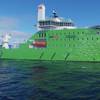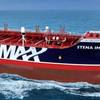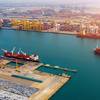Montco Offshore is the beneficiary of the latest innovative newbuild from the Bollinger Shipyards stable. The companies are touting the new L/B Myrtle, a 137.5 ft. unit, as a giant leap forward in the evolution of liftboats. The unit is outfitted with 245-ft. legs and the self-propelled floating platform has the ability to work in water depths to 180 ft. with a 15-ft. air gap while lifting a total of 850 KIPS of variable load. The feature that separates this liftboat from others, however, is that it is equipped with a bowthruster and controllable pitch (CP) propellers for greater maneuverability and pinpoint positioning of the huge legs with oversized pads on the ocean bottom.
"We always strive to give our customers the best possible service with the highest level of safety built-in," said Lee Orgeron, Montco's president. "The bowthruster, CP wheels and joystick operations give us the edge. With this high degree of control over the boat, we can more effectively avoid contact with underwater piping, can-holes, and other rig infrastructure. This extra equipment is very expensive. We put it on the L/B MYRTLE to help our customers improve their bottom line, while it helps us to have satisfied customers."
Orgeron said almost all liftboats use their main engines to either maneuver or operate the leg lift system while in neutral which interferes with positioning. "With this boat," he said, "we can maintain jacking speed and maneuvering and hold a precise position at the same time."
The vessel, named in honor of Myrtle Orgeron, mother of Lee Orgeron, is equipped with 40 by 16-ft. pads to provide for excellent bottom stability and greater deck loads. The L/B Myrtle can also jack with a full pre-load and its pre-load system has quick acting stainless steel dump valves.
It is equipped with three Nautilus cranes with 150, 50 and 25-ton capacities in an innovative configuration. The smaller crane is positioned on the starboard stern so that support vessels can tie-up to the liftboat and offload personnel, cargo, and/or fluids without hindering other work being done by the liftboat. The 150-ton crane has a 110-ft. boom and is equipped with VHF radio, loudhailer, load indicator and boom-mounted video camera with monitor to assist when load hook-ups are out of the normal view of the operator.
The boat is 137.5-ft. long, with a 92-ft. beam and hull depth of 13-ft. Open deck area is 6,000 sq. ft. Its three legs are 72 in. in diameter and are constructed of 1.5-in. wall thickness high strength steel. Power is supplied by two Caterpillar 3512 diesels developing a total of 3,000 bhp. They drive Berg controllable pitch propellers through Reintjes reduction gears. Electrical power is produced by two 190 kW generators driven by Caterpillar 3306 diesels. A 350 bhp hydraulic motor drives the bow thruster.
The Hydraquip jacking system is designed using the latest hydraulic and computer technology to accurately control the leg position. The programmable logic controller provides all jacking system logic, safety interlocks, leg position and alarm monitoring. The hydraulic system incorporates a three speed jacking system that allows leg tagging at 10 ft./min., normal jacking at 4 ft./min. and preload jacking at 2 ft./min. The jacking system has counterbalance (holding) valves at each motor for pinion isolation. All jacking system pressures, system status, temperatures, alarms, and operation manual are displayed on a liquid crystal plasma touch screen. The boat's fully equipped galley can serve 20 persons per seating and its 12 staterooms have 46 berths with three separate digital satellite television systems piped to 12 locations throughout the vessel. Navigation equipment includes radars, depth sounder, loudhailer, a GMDDS station, magnetic compass, wind speed and direction indicators, 2 VHF radios, a SSB radio, a global positioning system, dynamic positioning system and autopilot. Regulatory classifications are ABS loadline, SOLAS/MARPOL, USCG Subchapter L.
For more information on the companies in this article, circle the appropriate number on the Reader Service Card in this edition
ABS 14
Caterpillar 15
Berg 16
Nautilus 17
Hydraquip 18
Derecktor Premieres 53-ft. Water Taxi in NY
New York Water Taxi has accepted the delivery of Mickey Murphy - the first in a series of 53-ft. passenger ferries constructed by Derecktor Shipyards. The bright yellow boats, which sport a black and white checkered trim, are designed to enhance waterborne transportation for New York City residents, as well as the millions of tourists that visit the major attractions on the West Side, Lower Manhattan and Downtown Brooklyn Waterfront each year. Designed by Nigel Gee & Associates, the new Water Taxi is powered by two Detroit Diesel Series 60 engines, providing 600 hp at 2,100 rpm via Twin Disc gears. It is an all-aluminum catamaran with a low-wake hull and a top speed of 25 knots carrying 54 seated passengers. A bow-loader type, the vessel allows the passengers to disembark directly from the bow into the cabin located on the main deck. In addition, an ADA ramp allows easy access for wheelchairs, which are accommodated in various spaces throughout the cabin.
Able to hold 75 passengers, the vessel boasts 54 seats designed by Beurteaux, situated back-to-back so that passengers can enjoy panoramic views of the city during their ride. The vessel's open top deck has a removable seating arrangement for use in excursions and summer cruises.
For more information on the companies in this article, circle the appropriate number on the Reader Service Card in this edition
Derecktor Shipyard 10
Nigel Gee & Assoc. 11
Detroit Diesel 12
Twin Disc 13
Water Taxi Specifications
Name Mickey Murphy
Builder Derecktor Shipyard
Owner New York Water Taxi
Designer Nigel Gee & Associates
Material Aluminum
Length 53 ft.
Main engines Detroit Diesel
Power 600 hp @ 2,100 rpm
Gears Twin Disc
Capacity 75
Seats Beurteaux
Crowley Christens Tanker Escort Tug Response
Crowley extended its leadership role of providing the Pacific Northwest with the best available vessel escort vessels with the christening of its newest ship assist and escort tug named Response. The powerful tug was christened on Friday, August 2, at Pier 66 in Elliott Bay.
Deicy Mathur, wife of Anil Mathur, President of the Alaska Tanker Company, LLC, performed the christening ceremony aboard the Response. A team of Crowley engineers and architects designed the Response, with input from Crowley's ship assist and escort customer, Alaska Tanker Company.
Marco Shipyard built the tug in Seattle.
Tom Crowley, Jr., Chairman, President and CEO of Crowley Maritime said "I'm proud to say that this vessel was designed in the Northwest, built in the Northwest and will operate in the Northwest," said Crowley.
During tanker escorts Crowley tugs are tethered to, or shadow, tankers in the event braking or steering assistance is needed. Last year, Crowley tugs in Valdez, Alaska stopped a tanker that was in danger of colliding with a fishing boat that had its nets set across the shipping channel. Effectively slamming the brakes on a tanker requires a powerful, well designed tug like the Response, which, at 130 ft. in length and 7,200-hp, can provide enough indirect force to get the job done quickly and safely. Response features twin Voith Schneider 32G II/250 cycloidal propellers, powered by two Caterpillar 3608 DITA engines, and a unique high lift and streamlined hull designed to meet the indirect forces and speed requirements of the tankers operating in Puget Sound. The hull is derived from a design for the tug Boxer and was developed by Bukser og Berging, Norway. It is also equipped with full fire fighting capabilities and can carry 2,800 of foam concentrate.
Response is 129.5 ft. long, 45.67 ft. wide and 24.75 ft. deep. It is designed to generate direct bollard pull of 150,000 pounds and indirect forces in excess of 340,000 pounds at 12 knots.
Response is fitted with a Markey Model DESS-52 High Performance single-drum electric Hawser winch designed specifically for this vessel. The winch will hold 1,000 ft. of 10-in. circumference AmSteel Blue high molecular weight polyethylene line with an average strength of over one million pounds. This main line will be able to be hauled in at pressures of over twice the bollard pull of the boat's engines, a condition that can occur when escorting tankers at high speed.
"The winch is the only one in existence designed especially for this boat," said Todd Busch, Director of Sales for Crowley's ship assist and escort services. "Its ability to haul in line under load is unsurpassed." Crowley has put 13 newly built tractor type tugs into service during the past 4 years. These tugs represent the newest technology in tanker escort and ship assist. The Response incorporates some of the best design features of the Boxer, along with the proven capabilities of the recently built Crowley tugs. For more information on the companies in this article, circle the appropriate number on the Reader Service Card in this edition
Crowley Marine 19
Marco Shipyard 20
Markey 21
Amsteel 22
Caterpillar 23
Voith Schneider 24
USCG Commissions Patrol Boat
A commissioning ceremony for the Pacific Northwest's third and newest Marine Protector Class Cutter took place last month at Coast Guard Group Port Angeles, in Port Angeles, Wash. The Coast Guard Cutter Wahoo, an 87-ft. patrol boat, will assume the primary missions of search and rescue, law enforcement, and homeland security in the Strait of Juan de Fuca and Puget Sound. It is equipped with advanced state-of-the-art navigational technology, a fast small boat rear-launch system, and 25-knot capacity. Coast Guard Senior Chief Petty Officer Thomas J. Johnson is assumed the position of Officer in Charge of the Wahoo. This will be his second time in his 26-year career in the Coast Guard to be stationed in Port Angeles.
He comes to the Northwest from Eureka, Calif., where he was in command of the 87-ft. cutter Barracuda.
Crowther Hull,
Cummins Power for New Catamaran
Blount-Barker Shipbuilding of Warren Road Island have begun cutting aluminum for a 124-ft. whale watching catamaran. The vessel will have four Cummins KTA50 M2 engines rated for 1,800 hp each at 1,900 rpm for a total 7,200 hp. The engines will turn into ZF4600D marine gears linked to four Hamilton HM651 water jets.
Auxiliary power will be provided by a pair of Cummins Onan 95 Kw generator sets.
The 124 x 36 ft. catamaran designed with a main, mid and upper deck will accommodate 444 passengers at an operating speed of 40 knots. The vessel's structure will be designed to DNV Rules and Regulations for the classification of high-speed light craft and built to U.S. Coast Guard Subchapter K Rules and Regulations. The boat is being built to a design from Crowther Multihulls of Australia. This will be the company's largest North American boat to date following on successful Cummins powered 20-m vessels from Kvichak Marine International. The boat's assignment will be as a whale watch vessel based in Bar Harbor Maine. Delivery of the KTA50 main engines is scheduled for December of this year with the vessel being delivered to the owners in the spring of 2003. Blount-Barker president Jim Blount reports that the yard is currently negotiating with other customers for follow up vessels.
Whale Watch Boat Specifications
Builder Blount-Barker Shipbuilding
Boat design Crowther Multihulls
Dimensions 124 x 36 ft.
Main engines 4 x Cummins KTA 50 M2
Power 7,200 hp total
Gears ZF
Water Jets Hamilton
Passengers 444
Speed 40 kts.
Classification DNV
Subscribe for
Maritime Reporter E-News
Maritime Reporter E-News is the maritime industry's largest circulation and most authoritative ENews Service, delivered to your Email five times per week











